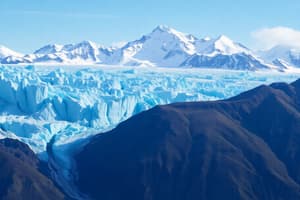Podcast
Questions and Answers
What are the three main types of glaciers described in the text?
What are the three main types of glaciers described in the text?
The three main types of glaciers described in the text are continental glaciers, alpine glaciers, and tidewater glaciers.
What are hanging valleys and how are they formed?
What are hanging valleys and how are they formed?
Hanging valleys are formed when a glacier carves out a deep valley and then melts, leaving the valley suspended in the mountain range. They usually end with a waterfall.
What are some of the landforms created by glaciers?
What are some of the landforms created by glaciers?
Some landforms created by glaciers include moraines, drumlins, and kettle lakes.
What are the two main types of glaciers and where can they be found?
What are the two main types of glaciers and where can they be found?
What is the process called when the pressure from a glacier causes ice at the base to melt and allows the entire glacier to move?
What is the process called when the pressure from a glacier causes ice at the base to melt and allows the entire glacier to move?
What are striations and how do they form?
What are striations and how do they form?
What are the two main types of glaciers? Provide a brief description of each.
What are the two main types of glaciers? Provide a brief description of each.
How do glaciers form? Explain the process.
How do glaciers form? Explain the process.
What is the difference between internal flow and basal sliding as modes of glacier movement?
What is the difference between internal flow and basal sliding as modes of glacier movement?
What are moraines and how are they formed?
What are moraines and how are they formed?
What are drumlins and how are they formed?
What are drumlins and how are they formed?
What are kettle lakes and how are they formed?
What are kettle lakes and how are they formed?
What are the three types of glaciers mentioned in the text and where are they found?
What are the three types of glaciers mentioned in the text and where are they found?
What are moraines and drumlins?
What are moraines and drumlins?
Why are glaciers important for fresh water sources and how are they affected by climate change?
Why are glaciers important for fresh water sources and how are they affected by climate change?
Flashcards are hidden until you start studying




